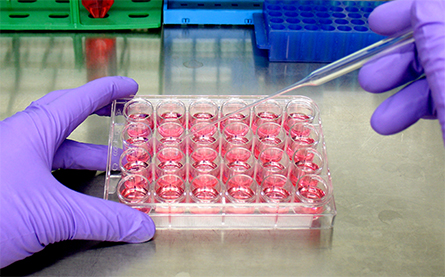Rethinking how culture medium contributes to cellular function
Cell culture medium, as we know, contains a combination of growth factors and other components that help researchers grow cells in the lab. An important constituent in the growth medium is serum, an animal-derived complex of growth factors, amino acids and lipids, which provides nutrition to the growing cells. Researchers lack complete information on serum composition and its lot-to-lot variability but have studied the effects of some growth medium components on cellular metabolism. However, they do not yet understand fully the impact of the medium’s lipid content on cell function.

The powerhouse of human cells is mitochondria. An important component that determines mitochondrial function is cardiolipins, or CLs. These phospholipids located on the inner mitochondrial membrane are involved in mitochondrial bioenergetics and maintaining architecture of the mitochondrial membranes as well as in scavenging reactive oxygen species. However, cardiolipin composition is different in different tissues of the body, and because CLs play a central role in mitochondrial function, this means cells in different organs have varied mitochondrial activity.
To better understand the effect of nutrition, especially lipids, on mitochondrial CL composition and function, Markus Keller’s lab at the Medical University of Innsbruck in Austria cultured mammalian cells in lipid-free medium and then fed them with various types of lipids. Using mass spectrometry lipidomics and mathematical modeling, the authors were able to quantify the CL composition in the presence of different fatty acids in the growth medium.
Specifically, addition of linoleic acid to the medium altered 76% of the natural CL side chain composition compared to untreated medium. Addition of alpha linolenic acid and arachidonic acid also altered CL side chain composition significantly. Moreover, linoleic acid treatment increased the activity of the mitochondrial respiratory complex I, which is responsible for generating ATP and thus regulates normal functioning of a cell. The lab’s breakthrough findings were published in the Journal of Lipid Research.
Gregor Oemer, the first author on the paper, said an initial challenge of this project was finding cells that would grow without lipids, which are usually necessary for cell proliferation. “We got Panserin 401 (a serum-free medium) from a German biotech company and luckily got our HeLa cells to grow in this lipid-free medium,” he said.
The work was a collaborative effort. “We were in luck because Innsbruck is the home base for Oroboros, one of the most renowned respirometry companies,” Oemer said, “and thanks to Erich Gnaiger, the head, we collaborated for the respirometry assays.”
This project was a continuation of Oemer’s master’s thesis from the Keller lab. “Lipid metabolism is very complex but quite fascinating, and we don’t know much about it,” he said.
What struck Oemer most was how, by just altering the lipid intake, the researchers were able to influence critical cellular functions. He hopes the work raises awareness that variations in serum in cell culture medium may alter experimental data. This is especially important while studying diseases such as Barth syndrome, a genetic disorder characterized by abnormalities in mitochondrial cardiolipins.
Enjoy reading ASBMB Today?
Become a member to receive the print edition four times a year and the digital edition monthly.
Learn moreGet the latest from ASBMB Today
Enter your email address, and we’ll send you a weekly email with recent articles, interviews and more.
Latest in Science
Science highlights or most popular articles

Defining a ‘crucial gatekeeper’ of lipid metabolism
George Carman receives the Herbert Tabor Research Award at the ASBMB Annual Meeting, March 7–10, just outside of Washington, D.C.

The science of staying strong
Muscles power every movement, but they also tell the story of aging itself. Scientists are uncovering how strength fades, why some species resist it and what lifestyle and molecular clues could help preserve muscle health for life.

Bacteriophage protein could make queso fresco safer
Researchers characterized the structure and function of PlyP100, a bacteriophage protein that shows promise as a food-safe antimicrobial for preventing Listeria monocytogenes growth in fresh cheeses.

Building the blueprint to block HIV
Wesley Sundquist will present his work on the HIV capsid and revolutionary drug, Lenacapavir, at the ASBMB Annual Meeting, March 7–10, in Maryland.

Gut microbes hijack cancer pathway in high-fat diets
Researchers at the Feinstein Institutes for Medical Research found that a high-fat diet increases ammonia-producing bacteria in the gut microbiome of mice, which in turn disrupts TGF-β signaling and promotes colorectal cancer.

Mapping fentanyl’s cellular footprint
Using a new imaging method, researchers at State University of New York at Buffalo traced fentanyl’s effects inside brain immune cells, revealing how the drug alters lipid droplets, pointing to new paths for addiction diagnostics.

